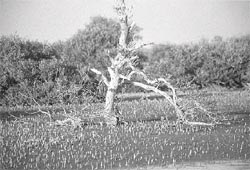How to avert disasters
 devastating cyclones come and go but nature and humans can help reduce the extent of damage. When we fail to protect nature and do not take preventive and corrective measures all things living suffer immensely. Last year's super cyclone that struck the coast of Orissa with wind-speeds of up to 300 km per hour was the severest of the century. The damage was extensive because a tidal surge lashed the coast and swept inland up to a distance of 15-25 km.
devastating cyclones come and go but nature and humans can help reduce the extent of damage. When we fail to protect nature and do not take preventive and corrective measures all things living suffer immensely. Last year's super cyclone that struck the coast of Orissa with wind-speeds of up to 300 km per hour was the severest of the century. The damage was extensive because a tidal surge lashed the coast and swept inland up to a distance of 15-25 km.
The loss of human lives was estimated at 20,000 in the cyclone affected area, many thousand heads of cattle perished as did numerous birds. Vast tracts of saline-inundated agricultural land were rendered unfit for cultivation and crops destroyed. Orissa has no disaster management plan.So the misery mounted. It will require generations to revive the agricultural economy of the affected areas.
Mangrove forests and sand dunes on the coastal belt act as natural barriers against cyclones or tidal surges. Sand dunes or bars are found to be of some help in low-level storm propelled tidal surges. Though most of Orissa is criss-crossed by rivers and creeks, the natural formation of dunes and bars are unusual and the few that exist are of very low height.
Earlier, long stretches of mangrove thrived along the coast. But human interference is rapidly reducing their numbers. Even after Independence long stretches of such forests existed in many parts of Orissa and 50 km from Dhamra mouth to Devi river mouth and beyond. However, following partition people from the neighbouring states infiltrated the areas and have been cutting down the trees to make way for agriculture. This influx continues even today.
However, the proliferation of prawn culture also poses a threat. In the entire stretch from Dhamra river mouth to Devi river mouth, the mangroves have been the worst affected despite legal protection. Also under attack are Bhitarakanika sanctuary and Mahanadi delta.
It is not surprising that there has been comparatively less damage to the hinterland in areas where mangrove forests exist. Today, it is an accepted fact that a large mangrove forest - acting as a buffer - will ensure minimum devastation to human settlements and the flora and fauna of the area.
In contrast, part of the tidal surge area is mangrove forest area which was destroyed after independence. The 1971 cyclone killed around 10,000 people because of the high tidal surge in a limited area of Mahakalapada police station of Kendrapara district above Paradeep port. The mangrove forests of the Mahanadi delta had been destroyed for resettlement of refugees. However, the Bhitarakanika mangrove forest, now a sanctuary, was least damaged. It prevented the high tidal surge and cyclone from crossing over and creating great havoc. Even in the recent, more violent cyclone there was no damage to the forests or wildlife of the sanctuary.
According to a government of India publication
Related Content
- Regional drought response plan for the Horn of Africa: 2023
- Groundswell Africa: a deep dive into internal climate migration in Nigeria
- Order of the National Green Tribunal regarding blast in the chemical factory run by Yashyashvi Rasayan Pvt. Ltd. at Dahej, District Bharuch, Gujarat, 03/02/2021
- Whatever it takes- A rapid and massive increase in aid is needed to save millions of lives and bring our divided world together amid the coronavirus pandemic
- Illegal mining puts Joburg on brink of disaster
- Somalia drought impact and needs assessment: synthesis report
